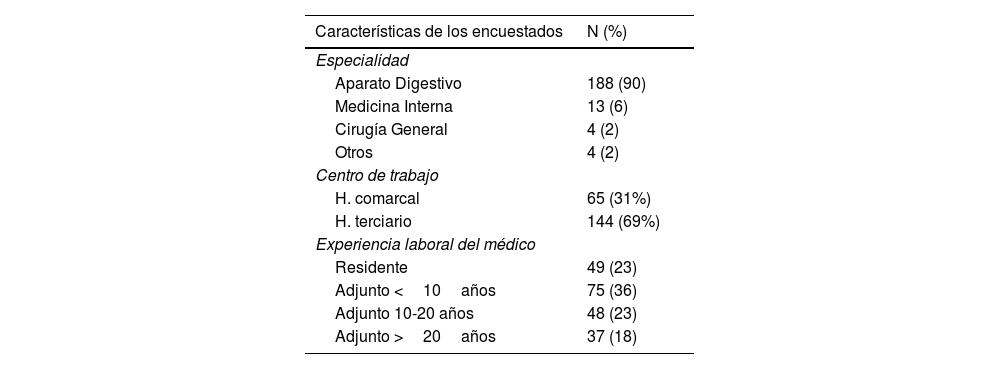La pancreatitis aguda constituye uno de los principales motivos de ingreso por causa digestiva. En su manejo resulta crucial un adecuado tratamiento del dolor. Pero apenas existen descripciones sobre las pautas analgésicas empleadas en nuestro medio.
MétodosEncuesta on-line sobre el manejo de analgésicos en la pancreatitis aguda, dirigida a médicos adjuntos y residentes con ejercicio en España.
ResultadosUn total de 209 facultativos de 88 centros respondieron la encuesta. El 90% eran especialistas en Aparato Digestivo y el 69% trabajaba en un centro terciario. La mayoría (64,4%) no utilizan habitualmente escalas para medir el dolor. Al elegir un fármaco se valora sobre todo la experiencia en su uso. Los tratamientos más prescritos inicialmente son: combinación de paracetamol y metamizol (53,5%), paracetamol solo (19,1%) y metamizol solo (17,4%). Como rescate: meperidina (54,8%), tramadol (17,8%), cloruro mórfico (17,8%) y metamizol (11,5%). Se utiliza perfusión continua en el 8,2% de los tratamientos iniciales. Los médicos con >10años de servicio utilizan más metamizol en monoterapia (50%), mientras que médicos residentes y adjuntos con <10años de servicio lo prescriben asociado a paracetamol (85%). Si se necesita progresar, se usan fundamentalmente cloruro mórfico y meperidina. La especialidad del encuestado, el tamaño del centro de trabajo y la unidad/servicio donde ingresaban los pacientes no influyeron sobre la analgesia pautada. El grado de satisfacción con el tratamiento del dolor alcanzó el 7,8/10 (DE 0,98).
ConclusiónEn nuestro medio, el metamizol y el paracetamol son los analgésicos más empleados como tratamiento inicial del dolor en la pancreatitis aguda, y la meperidina, el analgésico de rescate más utilizado.
Acute pancreatitis is one of the main reasons for digestive admissions. Adequate pain treatment is crucial in its management. However, there are hardly any descriptions of the analgesic guidelines used in our setting.
MethodsOn-line survey on analgesic management in acute pancreatitis, aimed at attending physicians and residents practising in Spain.
ResultsTwo hundred and nine physicians from 88 centres responded to the survey. Ninety percent were specialists in gastrointestinal medicine and 69% worked in a tertiary centre. The majority (64.4%) do not routinely use scales to measure pain. When choosing a drug, experience in its use was the most important factor. The most commonly prescribed initial treatments are: combination of paracetamol and metamizole (53.5%), paracetamol alone (19.1%) and metamizole alone (17.4%). As rescue: meperidine (54.8%), tramadol (17.8%), morphine chloride (17.8%) and metamizole (11.5%). Continuous perfusion is used in 8.2% of initial treatments. Physicians with >10 years of service use more metamizole as monotherapy (50%), while residents and attending physicians with <10 years of service prescribe it in combination with paracetamol (85%). If progression is needed, morphine chloride and meperidine are mainly used. The speciality of the respondent, the size of the work centre and the unit/service where the patients were admitted did not influence the analgesia prescribed. Satisfaction with pain management reached 7.8/10 (SD 0.98).
ConclusionIn our setting, metamizole and paracetamol are the most commonly used analgesics as initial pain treatment in acute pancreatitis, and meperidine is the most commonly used rescue analgesic.










